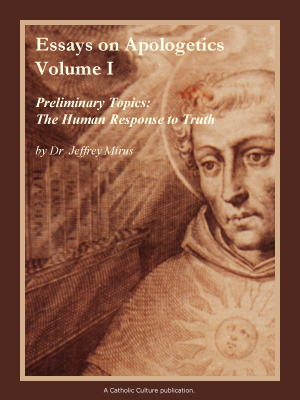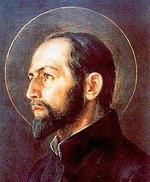The Fisher who fished for men, and died for it
By Dr. Jeff Mirus ( bio - articles - email ) | Jul 23, 2020
Among many things I have lost over the thirty-seven years since I was a professor at Christendom College are the lecture notebooks for my various classes in history and apologetics. For a few topics, from which I made a now extinct set of video lectures in the early days of Trinity Communications, I still have specific outlines and notes that I had typed into a computer. But too much of the knowledge I once had at my fingertips is lost.
Free eBook:

|
| Free eBook: Essays in Apologetics, Vol. I |
Among those lost items is the record of questions asked of parish clergy during an Anglican episcopal visitation in sixteenth-century England. Most of the clergy at mid-century would have been former Catholic priests. The questions were designed to assess how well-trained and well-educated these now-Anglican priests were, and so how fitted to carry out their responsibilities. Again, I have lost the details, but I recall that a large percentage could not enumerate the Ten Commandments and a smaller but significant percentage could not name the author of “the Lord’s prayer”.
Yes, this sounds like a trick question. But such ignorance was not uncommon in the last couple of centuries before the reforms initiated by the Council of Trent. In the late medieval period, the higher clergy tended to be of noble lineage. They controlled all the richer benefices (ecclesiastical properties), and they were typically important social and political figures: Only seldom were they deeply learned or even deeply spiritual. In any case, the ordinary parish churches—the poorer properties—were most often staffed by poor priests with relatively little training or formation, and even less education. Concubinage was rife among the lower clergy as well.
There were some serious efforts at Catholic reform beginning in the fifteenth century, but things were not consistently and decisively addressed until after the Protestant Revolt. This more concentrated effort at renewal was worked out and set in motion by the great Council of Trent (which met several times between 1545 and 1563). Still, in some places truly saintly bishops had already made a beginning—such as Saint Antoninus, the Archbishop of Florence, who died in 1459 and was canonized in 1523.
England
This deplorable situation was characteristic not only of the European continent but of England, at the time when Saints John Fisher and Thomas More were martyred for their refusal to take an oath which recognized King Henry VIII as the head of the Church there. More, of course, was a layman, but John Fisher was a bishop—in fact the only bishop to hold firm against the King’s pressure. He was not only a holy man but a real scholar, who had been preferred into his position in charge of Cambridge University, and ultimately as Bishop of Rochester, because of the respect in which he was held by Lady Margaret, the mother of King Henry VII, who himself had become serious about his Christian duties as his reign progressed. (Unfortunately, his son was Henry VIII.)
Fisher, who was a friend of two of the leading intellectual lights of his time—the holy Thomas More and the orthodox Erasmus—was very concerned with the renewal of the clergy, especially with respect to their learning and spirituality, for which he labored for years both at Cambridge and in his diocese. To put the matter at its simplest: There was a colossal dearth of effective preachers in the English Church, and it was essential as rapidly as possible to ensure that ecclesiastical promotions were made solely from “able men such as were virtuous and well-learned” (as Henry VII put it on his deathbed).
We know from that Anglican episcopal visitation and many other sources that the Protestant Reformation did not end this problem in the new “churches”. Over a century later, the great Puritan English poet, John Milton, could still write:
Blind mouths! That scarce themselves know how to hold
A Sheep-hook, or have learn’d ought else the least
That to the faithful Herdman’s art belongs…
The Hungry Sheep look up, and are not fed. [Lycidas, lines 119-25]
But John Fisher recognized the problem and did his best so solve it wherever he held authority. In an outstanding biography of the saint published in 1955, the remarkable researcher and historian E. E. Reynolds, said of Fisher:
Sometimes he is spoken of as if he were a survival from what we call the Middle Ages; this is a mistake. He was acutely aware of the problems of his own day; not the political questions which did not interest him, but the fundamental religious problems that became more and more pressing. His remedy lay in well-trained priests, men, who, with a sound theological basis, could preach to, and instruct their people. He welcomed whatever could advance that purpose; so he encouraged the New Learning while retaining what was good in the Old Learning. [Saint John Fisher (Anthony Clarke revised edition, 1972), p. 33]
An extraordinary account
I know this book by reputation, but I have so far read only the first twenty-percent of it. I don’t recall where I first picked it up—almost certainly decades ago—but it has been occasionally reprinted, and you can still find it on Amazon for as little as about $25 (or as much as $847 plus $3.86 for shipping!)—or even for just $12 in a Kindle edition. It was, I believe, most recently published by Mediatrix Press, edited by Ryan Grant, in 2015.
Though my memory of the book’s acquisition is gone, in the early 1970s while in graduate school at Princeton, I used to go to the library’s many “remainder” sales, where one could pick up unneeded duplicates of many fine donated books for as little as a dollar or two each. This was all pre-digital, of course. I can remember wandering among the book tables and loading bags full of intriguing books, many of them to bring home to my fiancée or new wife, depending on the year—until she begged me to stop. (We were married in 1972 despite my apparent lack of romantic flair. Perhaps I was stuck with the Reynolds volume then!)
I plan to report, lightly, more of St. John Fisher as I read the book. It is remarkable that Fisher and More were executed two weeks apart in 1535—Fisher on June 22nd at age 65 and More on July 6th at age 57. They knew each other well and respected each other immensely. Fisher was the only bishop in England to stand firm for the Church founded by Jesus Christ. The sadness now, perhaps, is that so few in most Western countries would find this remarkable. For that reason alone, St. John Fisher is particularly relevant to our time.
All comments are moderated. To lighten our editing burden, only current donors are allowed to Sound Off. If you are a current donor, log in to see the comment form; otherwise please support our work, and Sound Off!
-
Posted by: margaretinvirginia -
Jul. 25, 2020 7:51 PM ET USA
Dr. Mirus - you wrote: "Among many things I have lost over the thirty-seven years since I was a professor at Christendom College are the lecture notebooks for my various classes in history and apologetics." I was in some of your classes at Christendom in the early 1980's, and may still have my notes and handouts. If I don't, other alumni may. I suggest posting a request on the Christendom Alumni page to see what you can find!







